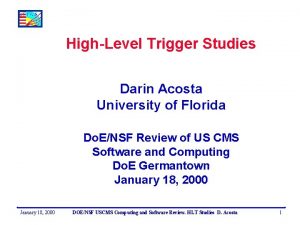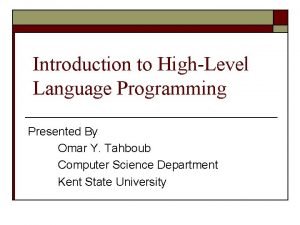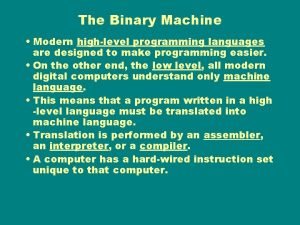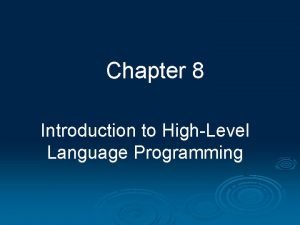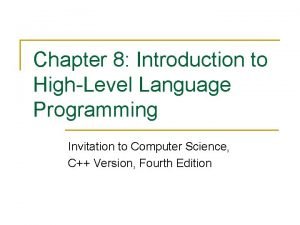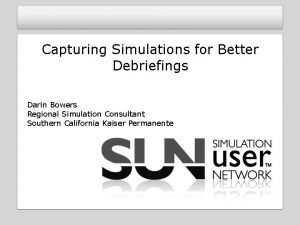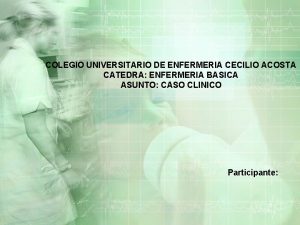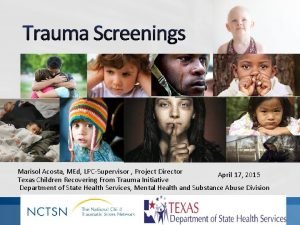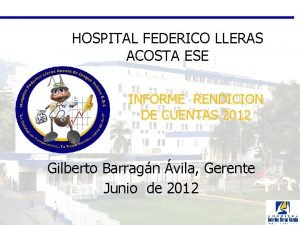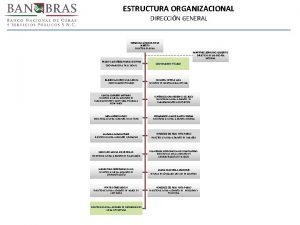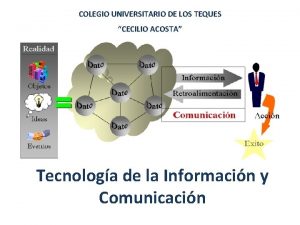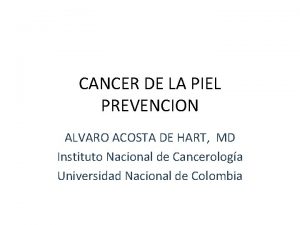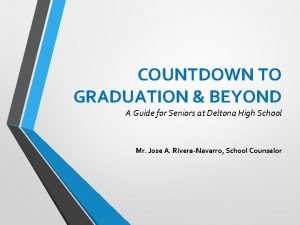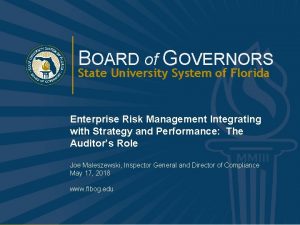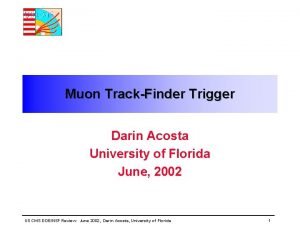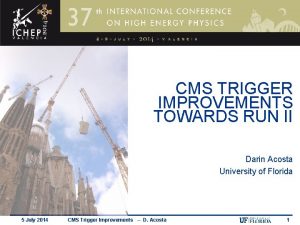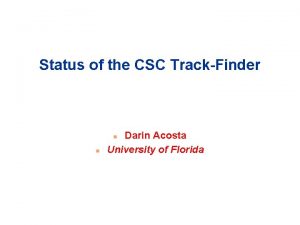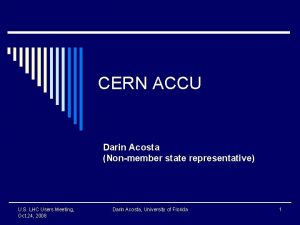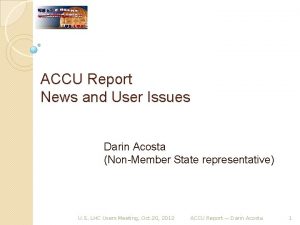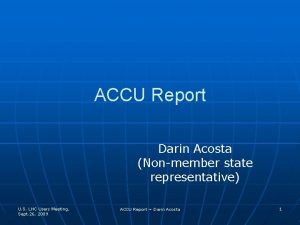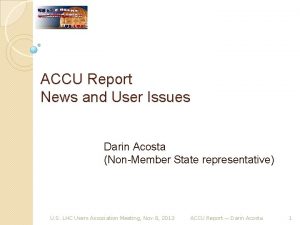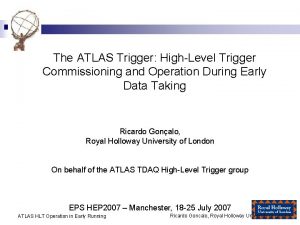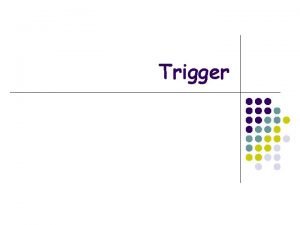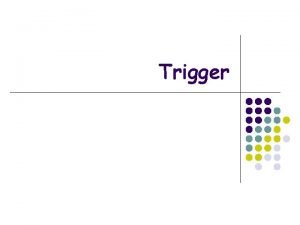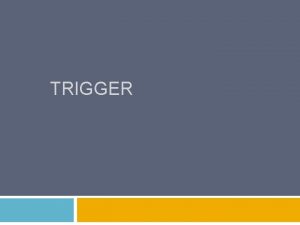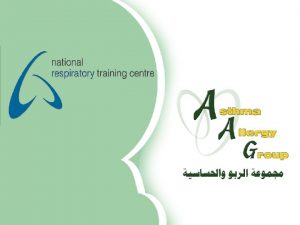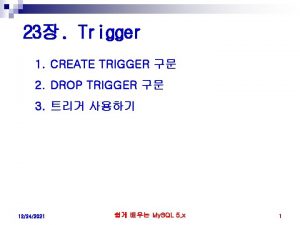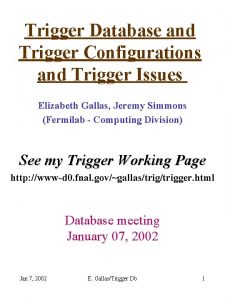HighLevel Trigger Studies Darin Acosta University of Florida


















- Slides: 18

High-Level Trigger Studies Darin Acosta University of Florida Do. E/NSF Review of US CMS Software and Computing Do. E Germantown January 18, 2000 DOE/NSF USCMS Computing and Software Review. HLT Studies D. Acosta 1

The CMS DAQ Architecture CMS has a multi-tiered trigger system: èL 1 reduces rate from 40 MHz to 100 k. Hz p. Custom hardware processes calorimeter and muon data to select e, , muon, jet, ET above threshold èL 2, L 3, … (HLT) reduces rate from 100 k. Hz to 100 Hz p. Commercial CPU farm runs online programs to select physics channels The CPU farm is fed by an Event Builder composed of readout buffers and a large network switch January 18, 2000 DOE/NSF USCMS Computing and Software Review. HLT Studies D. Acosta 2

The DAQ/HLT Challenge èDAQ hardware needs sufficient bandwidth p. Total event size is 1 MB, event rate is 100 k. Hz p. Bandwidth limited by switch and link technology èHLT selection algorithms must keep only 1 event per 1000 p. Limited by ability to filter a L 1 data sample which is already rich in physics These two needs are coupled. The needs of HLT drive the hardware, but hardware limitations drive the HLT algorithms èRequire “On-Demand” Reconstruction ORCA p. Pull data through switch only as needed (partial event reconstruction), and process only what is needed to keep the HLT latency low January 18, 2000 DOE/NSF USCMS Computing and Software Review. HLT Studies D. Acosta 3

The Physics Groups èFour Physics Reconstruction and Selection (PRS) groups were established by CMS in April, 1999 p. Electron/Photon C. Seez p. Muon U. Gasparini p. Jet/Missing ET S. Eno pb/tau A. Caner èOverall coordination by P. Sphicas èUS-CMS has substantial involvement in the Electron/Photon, Jet/Met and Muon groups p. Focus of the Calorimeter, Endcap Muon, and Tri. DAS construction project communities èThe charge is to evaluate the full chain from L 1 to offline on the physics capability of CMS p. Design and implement the algorithms and software to provide the necessary rejection in the L 1 and HLT triggers and to keep the efficiency high for the CMS physics plan January 18, 2000 DOE/NSF USCMS Computing and Software Review. HLT Studies D. Acosta 4

Context of Studies The L 1 Trigger TDR is targeted for November, 2000 èStill to need to pin down some parameters of the Muon and Calorimeter triggers based on these studies The DAQ TDR is targeted for November, 2001 èNeed to understand the rejection capability of the HLT triggers and the amount of data each step requires to validate possible hardware solutions A Physics TDR is planned for ~2003 èIt was actually delayed to allow for the transition to objectoriented software In all cases, we need to validate the algorithms for the CMS physics plan, taking into account all possible backgrounds January 18, 2000 DOE/NSF USCMS Computing and Software Review. HLT Studies D. Acosta 5

Strategy for Physics Groups Collaboration decided to deploy Object-Oriented software ORCA èHLT studies should be performed in this environment èORCA provides “On-Demand” reconstruction èNo reason in principle why online code should differ from offline code (other than source of data), except that CPU farm has fixed time constraints First HLT milestone for Physics Groups: èFor November 1999, show that we can get a factor of 10 rejection of the L 1 triggers using only 25% of the event data p. Calorimeter and muon data can be used, but only a tiny fraction of tracker data January 18, 2000 DOE/NSF USCMS Computing and Software Review. HLT Studies D. Acosta 6

Work Plan from April to Nov. ‘ 99 èWrite software for ORCA (in C++ as much as possible) p. Hit generation, digitization, L 1 trigger, reconstruction èProduce large Monte Carlo samples p. Fortran CMSIM package provides GEANT 3 hits to ORCA p. Must coordinate the CPU resources of many institutes èMake them persistent p. Store digitized hits in an Objectivity database èWrite user analysis jobs and produce Ntuples èDetermine L 1 rates and efficiencies p. Set the baseline èDevelop L 2 algorithms p. See what HLT can do This was an aggressive plan for 6 months time! January 18, 2000 DOE/NSF USCMS Computing and Software Review. HLT Studies D. Acosta 7

Trigger and Physics Challenges Electron/Photon: background from 0 s èAfter threshold, further rate reduction from p. Isolation (L 1–L 2), track match and E/p cuts (L 3) èPrimary Muon: èRate primarily from real muons! ( /K and leptonic b, c decays) èAfter threshold, further rate reduction from p. Isolation, topology (L 1–L 2) Jet/MET: èRate from jet production èAfter threshold, further rate reduction from p. Refined jet algorithms, coverage, granularity (L 1–L 2) B/tau: èRate reduction from tracking (L 3) èPrincipal challenge is how to design L 1 trigger without it January 18, 2000 DOE/NSF USCMS Computing and Software Review. HLT Studies D. Acosta 8

Technical Challenges for U. S. Groups Jet/MET and Electron/Photon èBasic calorimetry code existed for the ECAL at the outset èNeeded to be extended to HCAL in a unified way èDetailed simulation for pile-up had to be introduced (Apr. 99) (Endcap) Muon èBasic code existed for barrel muon system at outset (Apr. 99) èCode for endcap muon system had to be written from scratch p Detector technology and organization is completely different, is the entire L 1 trigger chain as In All Groups è Working environments had to be established p Manpower had to found p Regular meetings were arranged p User facility was established at Fermilab è Data handling facilities had to be set up p Caltech, Florida, UC Davis January 18, 2000 in the U. S. DOE/NSF USCMS Computing and Software Review. HLT Studies D. Acosta 9

U. S. Involvement U. S. makes up a large fraction of the Physics Groups Jet/MET Physics Group: èSubstantial U. S. contribution from 10 in all areas l. R. Wilkinson (Caltech), D. Green & W. Wu (FNAL), E. Mc. Climent (Iowa), S. Eno & S. Kunori (Maryland), P. Sphicas (MIT), D. Stickland & C. Tully (Princeton), S. Dasu (Wisconsin) Electron/Photon Physics Group: èSubstantial U. S. contribution from 6 in all areas l. S. Shevchenko & R. Wilkinson (Caltech), P. Vikas (Minnesota), P. Sphicas (MIT), D. Stickland & C. Tully (Princeton) Muon Physics Group: èSubstantial contribution from 7 in all areas l. R. Wilkinson (Caltech), P. Sphicas (MIT), R. Breedon & T. Cox(UCDavis), B. Tannenbaum (UCLA), D. Acosta & S. M. Wang (UFlorida), A unique opportunity to have lead role in CMS physics studies January 18, 2000 DOE/NSF USCMS Computing and Software Review. HLT Studies D. Acosta 10

Jet/MET and e/ HLT Accomplishments èA complete simulation, reconstruction, and analysis chain in ORCA was set up by the Nov. 1999 milestone p. Considerable U. S. involvement in meeting this milestone p. U. S. needs software engineering support for training and guidance èLarge MC data sets generated by Caltech p. Installed into Objectivity database at CERN p. Being made available at FNAL user facility (limited manpower and resources) èL 1 by Trigger rates and efficiencies determined èL 2 algorithms developed p. EM clustering, isolation, 0 rejection, bremsstrahlung recovery p. Jet algorithms, identification p. Typical rejection factors in 3 -10 range January 18, 2000 DOE/NSF USCMS Computing and Software Review. HLT Studies D. Acosta 11

L 1 Jet Trigger Rates January 18, 2000 DOE/NSF USCMS Computing and Software Review. HLT Studies D. Acosta 12

L 2 Single e/ Trigger Rate èRejection factor in range 3 -10 èEfficiency about 94% èHigher statistics needed January 18, 2000 DOE/NSF USCMS Computing and Software Review. HLT Studies D. Acosta 13

Muon HLT Accomplishments èA complete simulation, reconstruction, and analysis chain in ORCA was set up for (barrel) muon studies by the Nov. 1999 milestone (but just barely…) èAbout 100, 000 background events (min. bias and W/Z) were generated p. Single muon weighting scheme developed at CERN l. Reduces colossal data sets, but slight bug found later… p. Florida, èObjectivity èStandard UC Davis, and Italian groups produced samples database at CERN filled with digitized hits analysis Ntuples created èPreliminary obtained January 18, 2000 results on L 1 and L 2 rates and efficiencies were DOE/NSF USCMS Computing and Software Review. HLT Studies D. Acosta 14

Muon L 1 and L 2 Rates Factor 2– 6 rejection from improved PT resolution January 18, 2000 DOE/NSF USCMS Computing and Software Review. HLT Studies D. Acosta 15

Endcap Muon Accomplishments èFirst release of core reconstruction software for endcap muon system was completed by Nov. 1999 p. Includes geometry, digitization, persistency, L 1 trigger p. But the integration of all these packages is still ongoing… p. Offline OO track reconstruction is under development now èHLT studies were hampered by the need to get the reconstruction software written despite a small (and inexperienced) group èEndcap Muon community needs software engineering support to help guide this development and make it more robust and efficient èNevertheless, preliminary physics results on the endcap L 1 trigger performance were derived from CMSIM and non-ORCA software for the Nov. 1999 milestone p. Needed for L 1 Trigger TDR to validate scheme January 18, 2000 DOE/NSF USCMS Computing and Software Review. HLT Studies D. Acosta 16

EMU Single Muon L 1 Trigger Rate èRate is for L=1034 èTarget rate of 1 k. Hz per unit rapidity can be met with a threshold of 15 Ge. V only for a 3 -station sagitta measurement èL 1 hardware needs to be modified to include this feature January 18, 2000 DOE/NSF USCMS Computing and Software Review. HLT Studies D. Acosta 17

Conclusions U. S. took a lead role in HLT studies, and in a short period of time delivered software and results èVery preliminary results show an L 2 rejection factor of 5 Although substantial progress shown, the DAQ-HLT milestone was not met èNeeded more time for code to stabilize, and to develop HLT algorithms èLacked sufficient manpower and resources èCompletion of first milestone is expected by June 2000 èFuture milestones should demonstrate that 100 Hz DAQ rate is feasible with high physics efficiency (June 2001) User facilities and software/computing support is essential for U. S. physicists to maintain prominent role January 18, 2000 DOE/NSF USCMS Computing and Software Review. HLT Studies D. Acosta 18
 Darin acosta
Darin acosta Highlevel language
Highlevel language Highlevel programming language
Highlevel programming language Highlevel language
Highlevel language Highlevel language
Highlevel language Darin bowers
Darin bowers Cefalo caudal en enfermeria
Cefalo caudal en enfermeria Paula molina acosta
Paula molina acosta Marisol acosta
Marisol acosta Test del bastón de galtón
Test del bastón de galtón Hospital federico lleras acosta ese - sede limonar
Hospital federico lleras acosta ese - sede limonar Saul olivares ortega
Saul olivares ortega Colegio universitario cecilio acosta
Colegio universitario cecilio acosta Alvaro acosta de hart
Alvaro acosta de hart Paradigm shift from women studies to gender studies
Paradigm shift from women studies to gender studies Fsu cybersecurity major
Fsu cybersecurity major University of florida rolling admissions
University of florida rolling admissions Board of governors state university system of florida
Board of governors state university system of florida Pet 3351 ucf
Pet 3351 ucf
